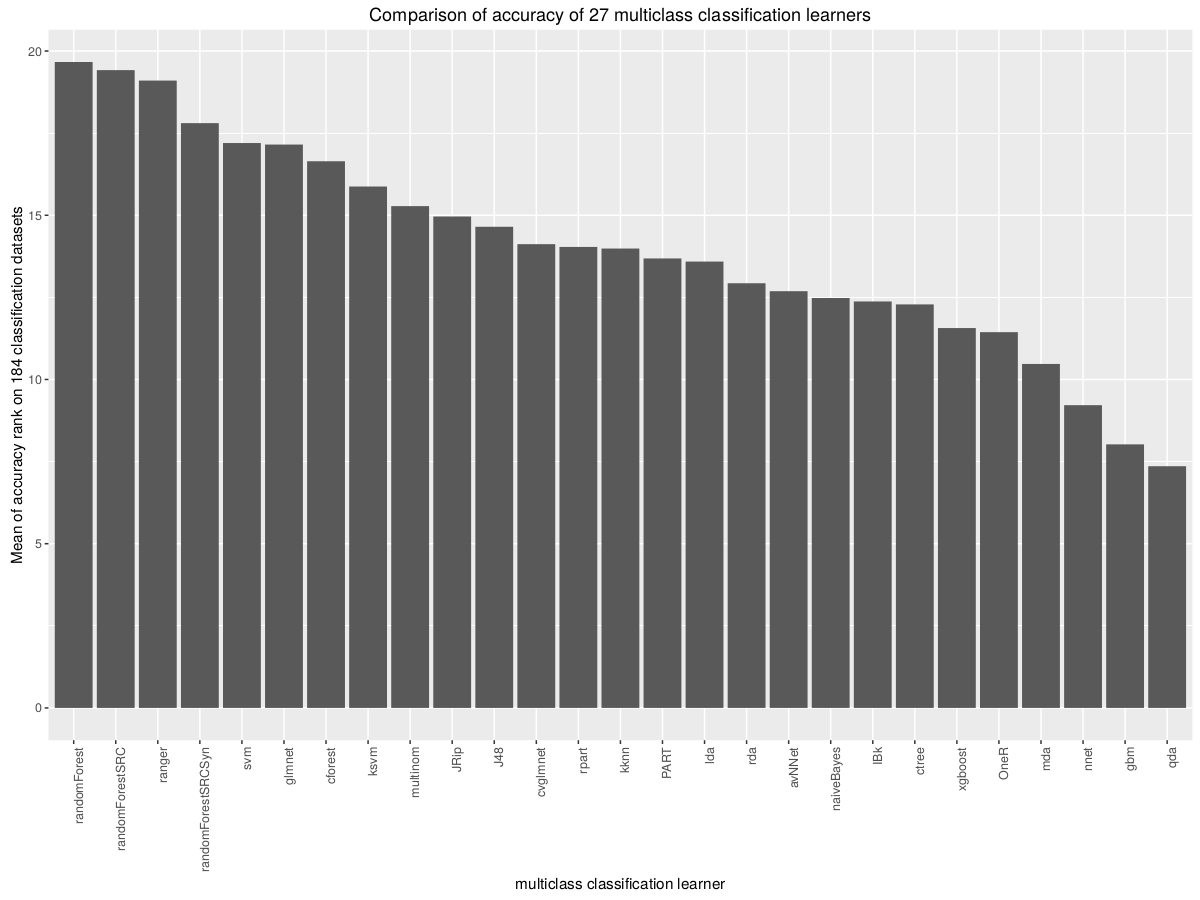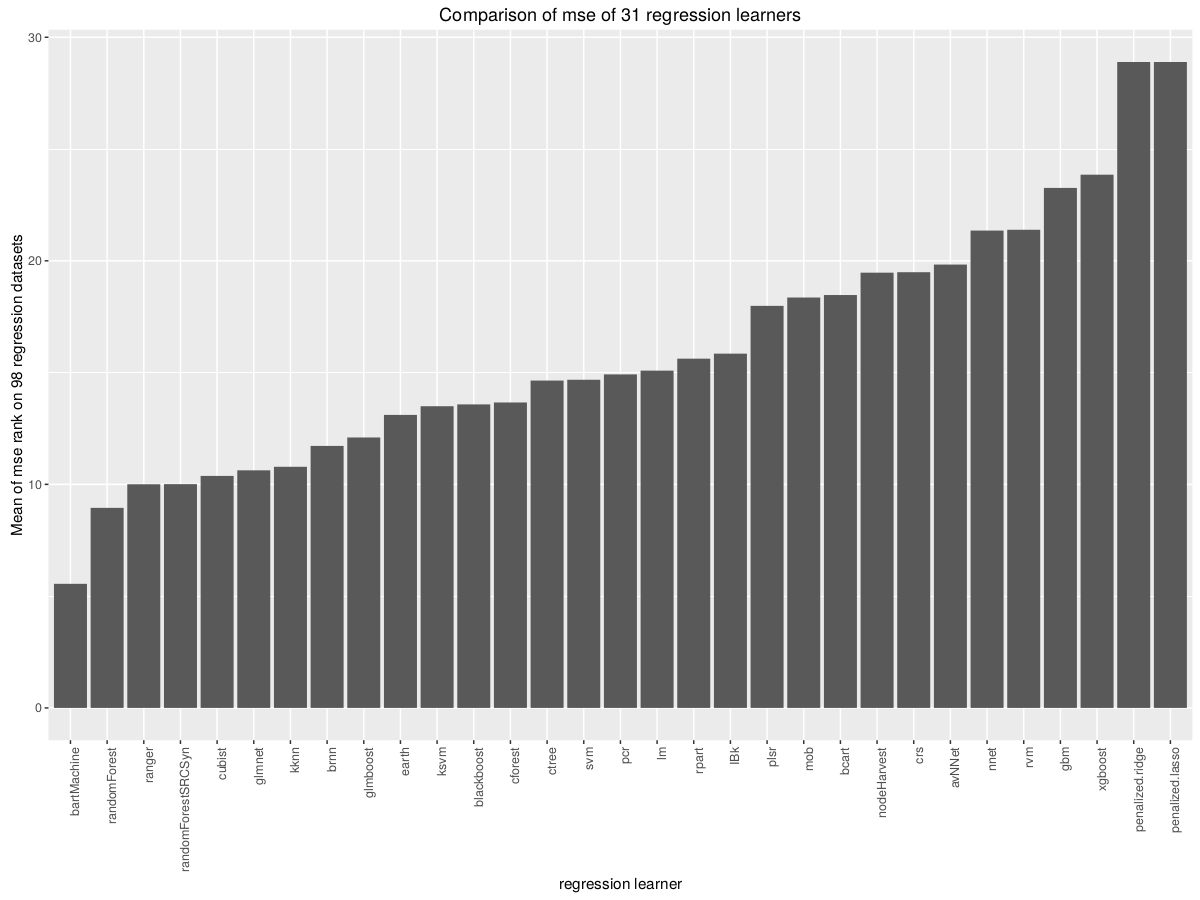Benchmark results (mlr-learners on OpenML)
There are already some benchmarking studies about different classification algorithms out there. The probably most well known and most extensive one is the Do we Need Hundreds of Classifers to Solve Real World Classication Problems? paper. They use different software and also different tuning processes to compare 179 learners on more than 121 datasets, mainly from the UCI site. They exclude different datasets, because their dimension (number of observations or number of features) are too high, they are not in a proper format or because of other reasons. There are also summarized some criticism about the representability of the datasets and the generability of benchmarking results. It remains a bit unclear if their tuning process is done also on the test data or only on the training data (page 3154). They reported the random forest algorithms algorithms to be the best one (in general) for multiclass classification datasets and the support vector machine (svm) the second best one. On binary class classification tasks neural networks also perform competitively. They recommend the R library caret for choosing a classifier.
Other benchmarking studies use much less datasets and are much less extensive (e.g. the Caruana Paper). Computational power was also not the same on these days.
In my first approach for benchmarking different learners I follow a more standardized approach, that can be easily redone in future when new learners or datasets are added to the analysis. I use the R package OpenML for getting access to OpenML datasets and the R package mlr (similar to caret, but more extensive) to have a standardized interface to machine learning algorithms in R. Furthermore the experiments are done with the help of the package batchtools, in order to parallelize the experiments (Installation via devtools package: devtools::install_github(“mllg/batchtools”)).
The first step is to choose some datasets of the OpenML dataplatform. This is done in the datasets.R file. I want to evaluate classification learners as well as regression learners, so I choose datasets for both tasks. The choosing date was 28.01.2016 so probably nowadays there are more available. I applied several exclusion criteria:
- No datasets with missing values (this can be omitted in future with some imputation technique)
- Each dataset only once (although there exist several tasks for some)
- Exclusion of datasets that were obviously artificially created (e.g. some artificial datasets created by Friedman)
- Only datasets with number of observations and number of features smaller than 1000 (this is done to get a first fast analysis; bigger datasets are added later)
- In the classification case: only datasets where the target is a factor
Of course this exclusion criteria change the representativeness of the datasets.
These exclusion criteria provide 184 classification datasets and 98 regression datasets.
The benchmark file on these datasets can be found here. For the classification datasets all available classification learners in mlr, that can handle multiclass problems, provide probability estimations and can handle factor features, are used. “boosting” of the adabag package is excluded, because it took too long on our test dataset.
For the regression datasets only regression learners that can handle factor features are included. The learners “btgp”, “btgpllm” and “btlm” are excluded, because their training time was too long.
In this preliminary study all learners are used with their default hyperparameter settings without tuning. The evaluation technique is 10-fold crossvalidation, 10 times repeated and it is executed by the resample function in mlr. The folds are the same for all the learners. The evaluation measures for classification are the accuracy, the balanced error rate, the (multiclass) auc, the (multiclass) brier score and the logarithmic loss and for regression the mean squared error, mean of absolute error, median of squared error and median of absolute error. Additionally the training time is recorded.
On 12 cores it took me around 4 days for all datasets.
I evaluate the results with help of the data.table package, which is good for handling big datasets and fast calculation of subset statistics. Graphics were produced with help of the ggplot package.
For comparison, the learners are ranked on each dataset. (see benchmark_analysis.R) There are a few datasets where some of the learners provide errors. In the first approach these were treated as having the worst performance and so all learners providing errors get the worst rank. If there were several learners they get all the averaged worst rank.
Classification
The results in the classification case, regarding the accuracy are summarized in the following barplot graphic:

It depicts the average rank regarding accuracy over all classification dataset of each learner.
Clearly the random forest implementations outperform the other. None of the three available packages is clearly better than the other. svm, glmnet and cforest follow. One could probably get better results for svm and xgboost and some other learners with proper tuning.
The results for the other measures are quite similar and can be seen here. In the case of the brier score, svm gets the second place and in the logarithmic loss case even the first place. SVM seems to be better suited for these probability measures.
Regarding training time, kknn, randomForestSRCSyn, naiveBayes and lda get the best results.
Instead of taking all datasets one could exclude datasets, where some of the learners got errors. The results are quite similar.
Regression
More interestingly are probably the results of the regression tasks, as there is no available comprehensive regression benchmark study to the best of my knowledge.
If an algorithm provided an error it was ranked with the worst rank like in the classification case.
The results for the mean squared error can be seen here:

It depicts the average rank regarding mean square error over all regression dataset of each learner.
Surprisingly the bartMachine algorithm performs best! The standard random forest implementations are also all under the top 4. cubist, glmnet and kknn also perform very good. The standard linear model (lm) is “unter ferner liefen”.
bartMachine and cubist are tree based methods combined with an ensembling method like random forest.
Once again, if tuning is performed, the ranking would change for algorithms like svm and xgboost.
Results for the other measures can be seen here. The average rank of cubist gets much better when regarding the mean of absolute error and even gots best, when regarding the median of squared error and median of absolute error. It seems to be a very robust method.
kknn also gets better for the median of squared and absolute error. Regarding the training time it is once again the unbeaten number one. randomForestSRCSyn is also much faster than the other random forest implementations. lm is also under the best regarding training time.
When omitting datasets where some of the learners produced errors, only 26 regression datasets remain. bartMachine remains best for the mean squared error. The results for the other learners change slightly. See here.